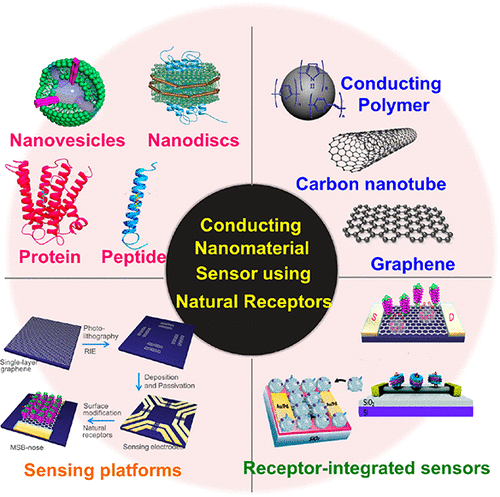当前位置:
X-MOL 学术
›
Chem. Rev.
›
论文详情
Our official English website, www.x-mol.net, welcomes your
feedback! (Note: you will need to create a separate account there.)
Conducting Nanomaterial Sensor Using Natural Receptors
Chemical Reviews ( IF 51.4 ) Pub Date : 2018-10-29 00:00:00 , DOI: 10.1021/acs.chemrev.8b00159 Oh Seok Kwon 1, 2 , Hyun Seok Song 3, 4, 5 , Tai Hyun Park 6 , Jyongsik Jang 6
Chemical Reviews ( IF 51.4 ) Pub Date : 2018-10-29 00:00:00 , DOI: 10.1021/acs.chemrev.8b00159 Oh Seok Kwon 1, 2 , Hyun Seok Song 3, 4, 5 , Tai Hyun Park 6 , Jyongsik Jang 6
Affiliation

|
One of the recently emerging topics in biotechnology is natural receptors including G protein-coupled receptors, ligand-gated ion channels, enzyme-linked receptors, and intracellular receptors, due to their molecular specificity. These receptors, other than intracellular receptors, which are membrane proteins expressed on the cell membrane, can detect extracellular stimuli. Many researchers have utilized cells with natural receptors embedded in the cellular membrane for human sense-mimicking platforms based on electrochemical impedance spectroscopy, quartz crystal microbalances, surface plasmon resonance, and surface acoustic waves. In addition, integration of conducting nanomaterials and natural receptors allows highly sensitive and selective responses toward target molecules, enabling, for example, nanobioelectronic noses for odorants, nanobioelectronic tongues for tastants, and G-protein-coupled receptor sensors for hormones, dopamine, cadaverine, geosmin, trimethylamine, etc. Moreover, as a part of nanobioelectronic sensors, natural receptors can be produced in various forms, such as peptides, proteins, nanovesicles, and nanodiscs, and each sensor can provide an ultralow limit of detection. In this Review, we discuss biosensors with natural receptors and then especially focus on natural receptor-conjugated conducting nanomaterial sensors. To provide a fundamental understanding, the sections encompass (1) the fabrication of conducting nanomaterials, (2) the production of natural receptors, (3) the characteristics of natural receptors, (4) the technology for immobilizing both components, and (5) their sensing applications. Finally, perspective is given on a new development in the use of natural receptors in a wide range of industries, such as food, cosmetics, and healthcare. In addition, artificial olfactory codes will be characterized by signal processing in the near future, leading to human olfactory standardization.
中文翻译:

使用自然受体传导纳米材料传感器
生物技术中最近出现的主题之一是天然受体,由于它们的分子特异性,包括G蛋白偶联受体,配体门控离子通道,酶联受体和细胞内受体。除了细胞内受体以外,这些受体是在细胞膜上表达的膜蛋白,可以检测细胞外刺激。许多研究人员已经利用电化学阻抗谱,石英晶体微天平,表面等离振子共振和表面声波将具有天然受体嵌入细胞膜的细胞用于人类感官模拟平台。此外,导电纳米材料和天然受体的整合可实现对目标分子的高度敏感和选择性反应,例如,可用于气味剂的纳米生物电子鼻,用于味觉的纳米生物电子舌,以及用于激素,多巴胺,尸胺,土臭素,三甲胺等的G蛋白偶联受体传感器。此外,作为纳米生物电子传感器的一部分,天然受体可以以各种形式产生,例如肽,蛋白质,纳米囊泡和纳米光盘,每个传感器都可以提供超低的检测限。在这篇综述中,我们讨论了具有天然受体的生物传感器,然后重点研究了天然受体共轭的导电纳米材料传感器。为了提供基本的理解,这些部分包括(1)导电纳米材料的制造,(2)天然受体的产生,(3)天然受体的特性,(4)固定两种组分的技术和(5)他们的感测应用。最后,对天然受体在食品,化妆品和医疗保健等众多行业中的使用的新发展给出了展望。另外,人造嗅觉代码将在不久的将来通过信号处理来表征,从而导致人类嗅觉标准化。
更新日期:2018-10-29
中文翻译:

使用自然受体传导纳米材料传感器
生物技术中最近出现的主题之一是天然受体,由于它们的分子特异性,包括G蛋白偶联受体,配体门控离子通道,酶联受体和细胞内受体。除了细胞内受体以外,这些受体是在细胞膜上表达的膜蛋白,可以检测细胞外刺激。许多研究人员已经利用电化学阻抗谱,石英晶体微天平,表面等离振子共振和表面声波将具有天然受体嵌入细胞膜的细胞用于人类感官模拟平台。此外,导电纳米材料和天然受体的整合可实现对目标分子的高度敏感和选择性反应,例如,可用于气味剂的纳米生物电子鼻,用于味觉的纳米生物电子舌,以及用于激素,多巴胺,尸胺,土臭素,三甲胺等的G蛋白偶联受体传感器。此外,作为纳米生物电子传感器的一部分,天然受体可以以各种形式产生,例如肽,蛋白质,纳米囊泡和纳米光盘,每个传感器都可以提供超低的检测限。在这篇综述中,我们讨论了具有天然受体的生物传感器,然后重点研究了天然受体共轭的导电纳米材料传感器。为了提供基本的理解,这些部分包括(1)导电纳米材料的制造,(2)天然受体的产生,(3)天然受体的特性,(4)固定两种组分的技术和(5)他们的感测应用。最后,对天然受体在食品,化妆品和医疗保健等众多行业中的使用的新发展给出了展望。另外,人造嗅觉代码将在不久的将来通过信号处理来表征,从而导致人类嗅觉标准化。











































 京公网安备 11010802027423号
京公网安备 11010802027423号